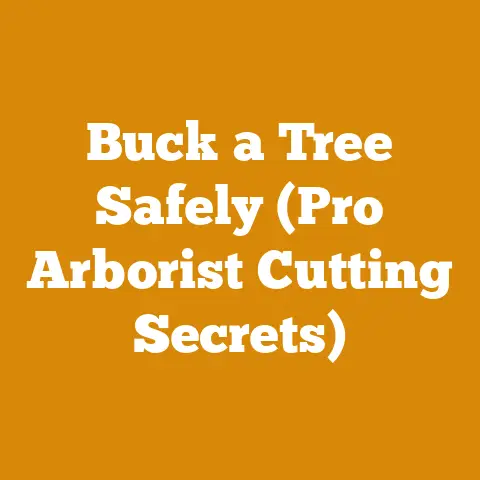Eucalyptus Tree Firewood: Growing Coppice for Efficient Harvest (Pro Tips)
Introduction: The Enduring Appeal of Eucalyptus Firewood
The allure of a crackling fire, the comforting warmth it provides, and the satisfaction of sustainably sourced firewood are timeless. For generations, humans have relied on wood as a primary heat source, and while technology has evolved, the fundamental principles of responsible forestry and efficient firewood preparation remain crucial. Eucalyptus, with its rapid growth and high energy content, has emerged as a popular choice for firewood, particularly when managed through coppicing. Coppicing, an ancient woodland management technique, allows for the repeated harvesting of shoots from a single tree stump, ensuring a sustainable supply of firewood for years to come.
Understanding Eucalyptus and Coppicing
Before diving into the practical aspects of growing and harvesting eucalyptus, it’s essential to understand the characteristics of this versatile tree and the principles of coppicing.
Eucalyptus: A Firewood Powerhouse
Eucalyptus encompasses a vast genus of over 700 species, native primarily to Australia. These trees are known for their rapid growth, adaptability to various climates, and high oil content, which contributes to their excellent burning properties.
- High Energy Content: Eucalyptus boasts a high density, translating to a substantial amount of energy per unit volume. This means longer burn times and more heat output compared to softer woods. Specifically, Eucalyptus species average around 28 million BTU (British Thermal Units) per cord, making them an efficient firewood choice.
- Rapid Growth: Certain eucalyptus species can grow several feet per year, making them ideal for sustainable firewood production. This rapid growth is due to their efficient photosynthetic processes and adaptability to various soil conditions.
- Variety of Species: Different eucalyptus species offer varying burning characteristics. Some are better suited for firewood than others. For instance, Eucalyptus globulus (Blue Gum) and Eucalyptus camaldulensis (River Red Gum) are popular choices due to their high density and heat output.
- Aromatic Qualities: The distinct aroma of burning eucalyptus adds to the ambiance of a fire, creating a pleasant sensory experience. The oils released during burning contribute to this characteristic scent.
My Experience: I remember the first time I burned eucalyptus firewood. The intense heat and the fragrant aroma were unlike anything I had experienced with other wood types. It quickly became my preferred choice for winter nights.
Coppicing: A Sustainable Harvesting Method
Coppicing is a traditional woodland management technique that involves cutting trees near ground level, stimulating the growth of multiple shoots from the stump. These shoots, known as “coppice stools,” can be harvested repeatedly over many years, providing a sustainable supply of wood.
- Sustainability: Coppicing allows for the continuous production of firewood without the need for replanting, making it an environmentally friendly practice. The root system remains intact, preventing soil erosion and promoting biodiversity.
- Faster Regrowth: Coppiced trees typically grow faster than newly planted seedlings, as they benefit from an established root system. This accelerated growth rate ensures a quicker return on investment.
- Improved Wood Quality: Coppicing can influence the quality of the wood produced. The younger shoots tend to have a higher density and fewer knots, resulting in better burning characteristics.
- Biodiversity Enhancement: Coppiced woodlands often support a diverse range of plant and animal life. The varying stages of regrowth create a mosaic of habitats, benefiting various species.
My Insight: I’ve seen firsthand how coppicing can transform a neglected woodland into a thriving ecosystem. The cyclical nature of harvesting and regrowth creates a dynamic environment that supports a rich variety of wildlife.
Takeaway: Understanding the benefits of eucalyptus firewood and the principles of coppicing is crucial for sustainable and efficient firewood production.
Selecting the Right Eucalyptus Species for Coppicing
Choosing the right eucalyptus species is paramount for successful coppicing and high-quality firewood production. Consider factors such as climate adaptability, growth rate, coppicing ability, and firewood characteristics.
Climate Adaptability
- Frost Tolerance: Some eucalyptus species are more tolerant of frost than others. If you live in an area with cold winters, select a species that can withstand freezing temperatures. Eucalyptus pauciflora (Snow Gum) is known for its exceptional frost tolerance.
- Drought Resistance: In arid or semi-arid regions, drought-resistant species are essential. Eucalyptus camaldulensis (River Red Gum) is well-adapted to dry conditions.
- Soil Type: Different eucalyptus species thrive in different soil types. Conduct a soil test to determine the pH and nutrient content of your soil and choose a species that is well-suited to those conditions. Eucalyptus sideroxylon (Red Ironbark) can tolerate poor soils.
Growth Rate and Coppicing Ability
- Rapid Growth: Opt for species that exhibit rapid growth, ensuring a quicker return on investment. Eucalyptus nitens (Shining Gum) is known for its exceptionally fast growth rate.
- Coppicing Vigor: Select species that readily coppice, producing numerous shoots after cutting. Eucalyptus viminalis (Manna Gum) is a reliable coppicer.
- Shoot Density: Consider the density of shoots produced after coppicing. A higher shoot density translates to a greater volume of firewood per stool. Eucalyptus grandis (Rose Gum) produces a dense cluster of shoots.
Firewood Characteristics
- Density: High-density wood burns longer and produces more heat. Eucalyptus globulus (Blue Gum) is renowned for its high density.
- Oil Content: Eucalyptus species with high oil content tend to burn hotter and produce a pleasant aroma. Eucalyptus radiata (Narrow-leaved Peppermint) is prized for its aromatic oils.
- Ease of Splitting: Some eucalyptus species are easier to split than others. Consider this factor if you plan to split the wood manually. Eucalyptus cladocalyx (Sugar Gum) is relatively easy to split.
Species Recommendations:
- Eucalyptus globulus (Blue Gum): High density, excellent heat output, but can be challenging to split. Ideal for colder climates.
- Eucalyptus camaldulensis (River Red Gum): Drought-resistant, good coppicing ability, and relatively easy to split. Suitable for drier regions.
- Eucalyptus viminalis (Manna Gum): Reliable coppicer, moderate density, and good all-around firewood species.
- Eucalyptus nitens (Shining Gum): Extremely fast-growing, but may require more frequent coppicing.
- Eucalyptus sideroxylon (Red Ironbark): Tolerates poor soils, high density, but can be slow-growing.
My Case Study: I conducted a small-scale trial comparing the growth rates and coppicing ability of Eucalyptus globulus and Eucalyptus camaldulensis in my region. While Eucalyptus globulus produced denser wood, Eucalyptus camaldulensis exhibited faster regrowth and better drought resistance, making it a more suitable choice for my specific conditions.
Actionable Metric: Monitor the growth rate of your chosen eucalyptus species by measuring the height and diameter of the shoots annually. Aim for an average annual height increase of at least 3 feet.
Takeaway: Carefully consider climate adaptability, growth rate, coppicing ability, and firewood characteristics when selecting the right eucalyptus species for your specific needs and location.
Establishing a Eucalyptus Coppice
Once you’ve selected the appropriate eucalyptus species, the next step is to establish your coppice. Proper site preparation, planting techniques, and initial management are crucial for long-term success.
Site Preparation
- Clearing Vegetation: Remove any existing vegetation, including grasses, weeds, and shrubs, that may compete with the eucalyptus seedlings for resources. Use a brush cutter or herbicide to clear the area. I’ve found that a combination of mechanical clearing and targeted herbicide application is most effective.
- Soil Preparation: Improve soil drainage and aeration by tilling or plowing the soil. Incorporate organic matter, such as compost or manure, to enhance soil fertility. A soil pH between 6.0 and 7.0 is ideal for most eucalyptus species.
- Weed Control: Implement a weed control strategy to minimize competition during the establishment phase. Mulching with wood chips or straw can suppress weed growth and conserve soil moisture.
Planting Techniques
- Planting Season: The best time to plant eucalyptus seedlings is during the dormant season (late winter or early spring) when the plants are less susceptible to stress.
- Spacing: Space the seedlings appropriately to allow for adequate growth and coppicing. A spacing of 8-10 feet between trees is generally recommended.
- Planting Depth: Plant the seedlings at the same depth they were growing in the nursery container. Avoid planting too deep, as this can suffocate the roots.
- Watering: Water the seedlings thoroughly after planting and continue to water regularly during the first few months to ensure proper establishment.
Initial Management
- Fertilization: Apply a balanced fertilizer to promote healthy growth. Follow the manufacturer’s instructions for application rates. I prefer slow-release fertilizers, as they provide a sustained release of nutrients over time.
- Pruning: Prune any dead or damaged branches to improve air circulation and prevent disease.
- Protection from Pests and Diseases: Monitor the seedlings for signs of pests and diseases and take appropriate action if necessary. Eucalyptus is susceptible to various pests, including eucalyptus longhorn borers and leaf beetles. Consult with your local agricultural extension office for recommendations on pest and disease control.
- Protection from Wildlife: Protect the seedlings from browsing animals, such as deer and rabbits, by using tree guards or fencing.
My Story: I once planted a large eucalyptus coppice without properly preparing the soil. The seedlings struggled to establish, and many died. I learned the hard way that thorough site preparation is essential for success.
Tool List:
- Brush cutter
- Tiller or plow
- Shovel
- Watering can or hose
- Fertilizer spreader
- Pruning shears
- Tree guards or fencing
Actionable Metric: Monitor the survival rate of your seedlings. Aim for a survival rate of at least 80% after the first year.
Takeaway: Proper site preparation, planting techniques, and initial management are crucial for establishing a healthy and productive eucalyptus coppice.
Coppicing Techniques for Efficient Harvest
Mastering coppicing techniques is essential for maximizing your firewood yield and ensuring the long-term health of your eucalyptus trees.
Timing of Coppicing
- Dormant Season: The best time to coppice eucalyptus is during the dormant season (late winter or early spring) when the trees are not actively growing. This minimizes stress on the plants and promotes vigorous regrowth.
- Age of Trees: The optimal age for the first coppicing varies depending on the species and growing conditions. Generally, eucalyptus trees can be coppiced after 3-5 years of growth.
- Coppicing Cycle: The coppicing cycle (the time between harvests) also depends on the species and growing conditions. A typical coppicing cycle for eucalyptus is 5-10 years.
Cutting Techniques
- Angle of Cut: Make the cuts at a slight angle (approximately 45 degrees) to promote water runoff and prevent rot.
- Height of Cut: Cut the trees as close to the ground as possible, ideally within a few inches of the soil surface. This encourages the development of multiple shoots from the stump.
- Sharpness of Tools: Use sharp tools to ensure clean cuts. Dull tools can damage the bark and increase the risk of disease.
- Safety Precautions: Always wear appropriate safety gear, including eye protection, gloves, and hearing protection, when using chainsaws or other cutting tools.
Post-Coppicing Management
- Thinning: Thin the coppice stools to promote the growth of the strongest and healthiest shoots. Remove any weak or damaged shoots. I typically thin the stools to 3-5 shoots per stump.
- Weed Control: Continue to control weeds around the coppice stools to minimize competition for resources.
- Fertilization: Apply fertilizer to promote rapid regrowth.
- Protection from Wildlife: Protect the coppice stools from browsing animals.
My Experience: I once coppiced a eucalyptus stand in the middle of the growing season. The trees experienced significant stress, and the regrowth was much slower than expected. I learned that timing is crucial for successful coppicing.
Tool List:
- Chainsaw
- Pruning saw
- Loppers
- Axe
- Wedges
- Safety glasses
- Gloves
- Hearing protection
Actionable Metric: Track the number of shoots produced per coppice stool. Aim for an average of at least 5 shoots per stump.
Takeaway: Proper timing, cutting techniques, and post-coppicing management are essential for maximizing your firewood yield and ensuring the long-term health of your eucalyptus trees.
Firewood Processing: From Tree to Hearth
Once you’ve harvested your eucalyptus wood, the next step is to process it into firewood. This involves cutting, splitting, and seasoning the wood.
Cutting to Length
- Firewood Length: Cut the wood to the appropriate length for your fireplace or wood stove. A common length is 16 inches, but this may vary depending on the size of your appliance.
- Chainsaw Safety: Use a chainsaw to cut the wood to length. Always follow proper safety procedures and wear appropriate safety gear.
- Bucking Techniques: Learn proper bucking techniques to minimize the risk of kickback and other chainsaw hazards.
Splitting
- Splitting Wedge and Maul: Use a splitting wedge and maul to split the wood. Place the wedge on the end of the log and strike it with the maul.
- Hydraulic Log Splitter: Consider using a hydraulic log splitter for larger or more difficult-to-split logs. Hydraulic log splitters can significantly reduce the amount of physical effort required to split wood. I’ve found that a log splitter with a 20-ton capacity is sufficient for most eucalyptus species.
- Splitting Techniques: Split the wood along the grain to make the process easier. Avoid splitting knots, as they can be difficult to break.
Seasoning
- Stacking: Stack the split wood in a well-ventilated area to allow it to dry. Stack the wood in rows, leaving gaps between the rows for air circulation. I typically stack my firewood in rows that are 4 feet high and 8 feet long.
- Covering: Cover the top of the woodpile to protect it from rain and snow. Avoid covering the sides of the pile, as this will restrict air circulation.
- Drying Time: Allow the wood to season for at least 6-12 months before burning. Eucalyptus can take longer to season than softer woods.
- Moisture Content: The ideal moisture content for firewood is below 20%. Use a moisture meter to check the moisture content of the wood before burning.
My Tip: I’ve found that elevating the woodpile off the ground using pallets or cinder blocks improves air circulation and accelerates the seasoning process.
Tool List:
- Chainsaw
- Splitting wedge
- Maul
- Hydraulic log splitter (optional)
- Moisture meter
- Pallets or cinder blocks
Actionable Metric: Use a moisture meter to measure the moisture content of your firewood. Aim for a moisture content below 20% before burning.
Takeaway: Proper cutting, splitting, and seasoning are essential for producing high-quality firewood that burns efficiently and safely.
Safety Considerations for Eucalyptus Firewood
While eucalyptus is an excellent firewood choice, it’s important to be aware of certain safety considerations.
Creosote Buildup
- Higher Oil Content: Eucalyptus has a higher oil content than some other wood species, which can contribute to creosote buildup in chimneys.
- Regular Chimney Cleaning: It’s essential to have your chimney cleaned regularly to prevent creosote buildup and reduce the risk of chimney fires. The National Fire Protection Association (NFPA) recommends that chimneys be inspected and cleaned at least once a year.
Sparking
- Potential for Sparking: Eucalyptus can be prone to sparking, especially when it’s not fully seasoned.
- Fireplace Screen: Use a fireplace screen to prevent sparks from escaping and causing a fire.
- Outdoor Burning: Exercise caution when burning eucalyptus outdoors, and keep a water source nearby in case of sparks.
Handling Precautions
- Protective Gear: Wear gloves when handling eucalyptus wood, as the oils can irritate the skin.
- Dust Mask: Wear a dust mask when cutting or splitting eucalyptus, as the dust can be irritating to the respiratory system.
- Chainsaw Safety: Always follow proper chainsaw safety procedures to prevent accidents.
My Advice: I always keep a fire extinguisher readily accessible when burning firewood, regardless of the species. It’s a simple precaution that can make a big difference in an emergency.
Actionable Metric: Schedule a professional chimney inspection and cleaning at least once a year.
Takeaway: Be aware of the safety considerations associated with eucalyptus firewood, and take appropriate precautions to prevent accidents and ensure safe burning.
Advanced Techniques for Eucalyptus Firewood Production
For those looking to optimize their eucalyptus firewood production, here are some advanced techniques to consider.
Timber Grading
- Quality Assessment: Timber grading involves assessing the quality of the wood based on factors such as knot size, grain pattern, and presence of defects.
- Sorting and Pricing: Grading allows you to sort the wood into different categories and price it accordingly. Higher-grade wood can be sold for a premium.
- Maximizing Value: Timber grading can help you maximize the value of your eucalyptus firewood.
Sawmill Operations
- Efficient Processing: If you have a large volume of eucalyptus wood to process, consider investing in a small sawmill. Sawmills can efficiently convert logs into lumber or firewood.
- Custom Cutting: Sawmills allow you to custom cut the wood to specific dimensions.
- Increased Production: Sawmills can significantly increase your firewood production capacity.
Kiln Drying
- Accelerated Seasoning: Kiln drying is a process that uses heat to accelerate the seasoning process.
- Reduced Moisture Content: Kiln drying can reduce the moisture content of the wood to below 10%, making it ideal for burning in high-efficiency stoves.
- Improved Burning Characteristics: Kiln-dried firewood burns hotter and cleaner than air-dried firewood.
Value-Added Products
- Kindling: Produce kindling from small branches and twigs.
- Wood Chips: Convert leftover wood into wood chips for landscaping or mulching.
- Biochar: Create biochar from eucalyptus wood for use as a soil amendment.
My Innovation: I experimented with using a solar kiln to dry eucalyptus firewood. The results were impressive, significantly reducing the seasoning time and improving the burning characteristics of the wood.
Takeaway: Advanced techniques such as timber grading, sawmill operations, kiln drying, and value-added products can help you optimize your eucalyptus firewood production and increase your profitability.
Conclusion: Embrace the Warmth and Sustainability of Eucalyptus Firewood
Growing and harvesting eucalyptus for firewood through coppicing is a rewarding and sustainable practice. By understanding the characteristics of eucalyptus, mastering coppicing techniques, and following proper firewood processing procedures, you can enjoy the warmth and comfort of a crackling fire while contributing to a healthier environment. Remember to prioritize safety, stay informed about the latest advancements in wood processing technology, and always strive to improve your efficiency and sustainability. Embrace the timeless appeal of firewood and the enduring benefits of eucalyptus. I hope this guide has provided you with the knowledge and inspiration you need to embark on your own eucalyptus firewood journey.






